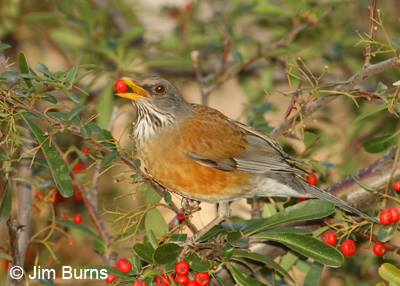
Down here in the canyon all that fades into background. Down here in the canyon is the real world. My mind is focused on the elusive robin, the "Mexican" Robin as Gonzalo calls it. My lens is focused on the Pyracantha bush twenty yards across the path laden with ripe red-orange berries. It was below freezing here overnight, but now morning light is spilling over the lip of Picketpost Mountain behind me and sunshafts are creeping down the rock wall behind the Pyracantha.
The first thing birds do in the morning is the first thing you do in the morning. You call it breakfast. They know it as survival. Sometimes in cold weather they won't expend the energy until the sun has warmed up their protein which we call bugs. But the frugivorous species don't need to wait. Already the Pyracantha has hosted multiple Hermit Thrushes. White-crowned Sparrows are busy under the bush cleaning up the berry detritus from Monday night's storm.
The "Mexican" Robin, officially known as Rufous-backed Robin, is an endemic breeding species in western Mexico that shows up in winter somewhere north of the border almost annually now, a "reverse" migration presumably linked to drought and/or poor berry crops at home. With its rusty cloak and orange eye ring, the Rufous-backed is a jazzed up version of our American Robin, eagerly sought by birders as much for its colorful variation on the common thrush template as for its rarity.
A larger bird slips down the wall, through the shadows, and lands in the back side of the Pyracantha. Only its tail is visible through the foliage, but the flight was too flippy, probably just a thrasher. Another bird, with more direct flight, comes from across the trail and lands half hidden amongst the berries. The shape is right, but . . . as it moves to a perch closer to the fruit I see it is just an American Robin. A bird with reddish tones that I hadn't even seen exits the back side of the bush. I turn and watch as it flies toward the creek, its undulating, woodpecker flight confirming it to be a Red-shafted Flicker. The Pyracantha is an avian drive through on this cold morning.
I turn back to the bush and can't believe my eyes. Our visitor from Mexico has materialized, unannounced, nearly in front of my lens, perhaps just an apparition. I neither heard nor saw it fly in. It moves! it is real! If it takes one more hop to the cluster of berries on which I am focused, I will catch it in the act, a berry in its mouth. It takes that hop. Click. I have hit the lottery.
Time stands still, frozen, like the robin before me, illuminated by sunshaft superimposed on dark green leaves, red berry in yellow beak, orange eyering and rusty cloak emblazoned in full living color on the sensor of the camera, etched forever on the sensor of my brain. This is probably what Eden was like . . . before the apple, before wayward sons, before illness and shamans, before the invention of the wheel. The real world. When Man and Nature were one.